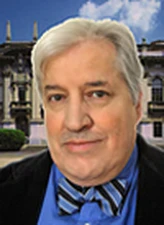Renzo Rosso

The 2010 Henry Darcy Medal is awarded to Renzo Rosso for his fundamental contributions to hydrology and water resources management.
The activity of Renzo Rosso is characterised by exceptional creativity and inventiveness, impact on the profession and in particular by outstanding efforts in dissemination. Rosso has always been keenly interested in producing top research contributions relevant to the fate of the environment in particular at the boundary of several disciplines like geomorphology, ecology and hydrology. The conceptual thread that joins his achievements is to be seen in that context.
At an early stage of his career in the ‘80s, Rosso deeply investigated geomorphological issues in river basins. He pioneered studies on the fractal nature of river networks, as he established the linkage between dendritic properties of natural channels and their hydrological response to precipitation, leading to flood formation. His research in this field led to well-known and now established theories concerning the geomorphological response of rivers, in particular the linkage of fractal geometry to Horton-Strahler ordering schemes. His 1989 paper co-authored with Paolo La Barbera titled “On the fractal dimension of stream networks” is a standard reference of the field, collecting more than 100 citations, and is widely considered a classic.
He also extensively studied geomorphological implications of bed and suspended load in rivers, including both fine and coarse sediments (e.g. dead wood), proposing innovative theories to explain observed patterns of variability, based upon both laboratory and field scale innovative experimental set-ups.
In the last two decades, he moved forward to use distributed hydrological models to investigate geomorphological processes at the hill-slope scale, including run-off formation, sheet flow, hill slope erosion, and shallow landsliding, explicit modelling of the effect of vegetation dynamics and forest fires within arid and semiarid basins, and triggering and dynamics of snow avalanches upon mountain hillslopes.
Rosso has fundamentally contributed, jointly with students and collaborators, to our understanding of hydrological processes at the hill-slope and watershed scale. At the hill-slope scale he investigated infiltration processes and the influence of fires on both infiltration and sediment erosion. These research topics were approached both theoretically and via in situ experiments. In the early 90s, when hydrological modelling entered the era of distributed approaches, he tackled, together with several Ph.D. students, the potential and the limitations of distributed modelling, including the effect of distributed radiation over complex topographies, the energy balance of snow-melt and soil-vegetation-atmosphere processes, also using remotely sensed data. The attention to the scale of representation of processes was always crucial in his modelling approach. He further devoted considerable effort towards understanding climate change impact on watershed hydrology, with particular emphasis upon mountain watersheds and water distribution resources therein. Most relevant are his contributions to statistical and stochastic hydrology. Over the last decades Rosso has pioneered investigations in the field of statistical hydrology. His area of interest covered statistical methods for assessing extreme floods using univariate and multivariate statistics, and scale invariance concepts applied to storms and floods. He explored scaling relationships holding in precipitation distribution in time and space, and delivered consistent approaches for model recognition and estimation for engineering purposes, e.g. IDF curves for design storm, regionalisation of flood frequency estimates, and downscaling of precipitation, and snow depth precipitation for assessment of snow avalanche hazard. He explored the use of bivariate distribution using copulas for statistical modelling of precipitation and floods in view of engineering design, thereby paving the way for a number of scientists to move forward. In stochastic hydrology he shed light on methods for identifying and modelling long-memory and non-stationarity in precipitation and run-off time series at different scales. His books and papers are indeed standard references in the field. His 1997 book Statistics, probability, and reliability for civil and environmental engineers, co-authored with Nathabandu T. Kottegoda, is a staple of modern engineering education. Breakthrough papers need not be comprehensive, or even precise in outlining all cases, stating all assumptions precisely and the implications of what has been left out. They need to be visionary, suggest new areas of field or theoretical research, to inspire colleagues to look after the validity of the assumptions and the significance of the examples, and to grab the essence of a problem of definite importance. All of the above have happened with at least five of Rosso’s papers.
He has displayed during his carrier the sort of attitude that develops innovative research, as well as a broad approach to important topics in hydrological sciences, which is required of major peers’ recognition. He always foresaw the important and emerging subjects of investigation in the worldwide community of hydrological sciences, and drove several young researchers towards the development of the modern concept of hydrology. Rosso, a brilliant seminar lecturer and professor, was able to attract to hydrology hundreds of MSc students and motivated tens of Ph.D. students to focus on curiosity-driven research related to engineering applications, never forgetting the initial purely speculative approach. Several of his former students are now professors in Italy and abroad. This speaks per se for his major legacy in academia. Rosso showed a scientist’s knowledge, an historian’s curiosity, and an environmentalist’s heart. His books and papers are exceptionally creative in that they introduced new observations, modelling and tools that redefine important engineering problems.
